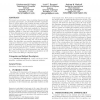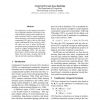446 search results - page 14 / 90 » Learning discrete categorial grammars from structures |
CORR
2010
Springer
13 years 6 months ago
2010
Springer
Learning structured representations has emerged as an important problem in many domains, including document and Web data mining, bioinformatics, and image analysis. One approach t...
IUI
2006
ACM
14 years 1 months ago
2006
ACM
Sketch interfaces provide more natural interaction than the traditional mouse and palette tool, but can be time consuming to build if they have to be built anew for each new domai...
IMC
2007
ACM
13 years 9 months ago
2007
ACM
The ability to discover network organization, whether in the form of explicit topology reconstruction or as embeddings that approximate topological distance, is a valuable tool. T...
GECCO
2009
Springer
14 years 4 days ago
2009
Springer
We present a novel stereo vision modeling framework that generates approximate, yet physically-plausible representations of objects rather than creating accurate models that are c...
ACL
2008
13 years 9 months ago
2008
The standard set of rules defined in Combinatory Categorial Grammar (CCG) fails to provide satisfactory analyses for a number of syntactic structures found in natural languages. T...


